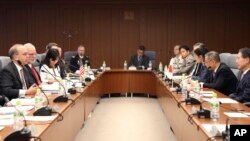U.S. and Japanese officials on Wednesday laid out guidelines for significantly expanded security coordination between the two nations, in order to better respond to what one senior state department official described as "the modern threat environment."
Speaking in Washington, the official described the interim guidelines as an "important milestone" toward revising U.S.-Japan defense cooperation, aimed at deterring regional and international threats.
The report does not mention any specific threats, but one senior Pentagon official said changes in the Asia-Pacific region over the past two decades -- including in the arena of cyberspace -- North Korea, and China's rise as a military and economic power were contributing factors to the revised guidelines.
According to those guidelines, the aim is to be able to address any situation that "affects the peace and security of Japan, threatens regional or global stability, or other situations that may require an alliance response."
It lists intelligence, surveillance, reconnaissance, use of facilities, air and missile defense, and maritime security among areas in which Japan and the United States plan to expand their cooperation.
The government of Japan on July 1, 2014 eased restrictions on its military in a historic move away from the country’s pacifist, post-World War II policies. The move was seen as necessary to help Japan play a “more proactive” role in the region, where China’s influence is rising, as well as to allow Japan to defend friendly nations that come under attack.
Japanese Prime Minister Shinzo Abe has boosted his country's spending on defense by 2.2 percent, to $48 billion, for fiscal year 2014.
The Pentagon official said regional nations, including Australia, South Korea and China, were briefed on the talks, and given an opportunity to ask questions and get answers on the process.
"We are committed to have a very open and transparent process," the official said, speaking on condition of anonymity.
Chinese Foreign Ministry spokesman Hong Lei responded to the news Wednesday by saying Beijing will be watching the revisions very closely.
"The Japan-US alliance is a bilateral arrangement formed under specific historical conditions. It should not go beyond the scope of bilateral cooperation and it must not harm the interest of third parties, including China," he said.
The guidelines lay out additional areas of cooperation between the United States and Japan, including in space and cyberspace. It includes increased information and intelligence sharing, peacekeeping operations, international humanitarian assistance, logistics support and civilian evacuation operations.
Further discussions and consultations between the allies are expected later in the year to work out details of the guidelines, leading to a final report.
That report will not be a legally binding document.
The last time the United States and Japan revised their defense guidelines was in 1997.
